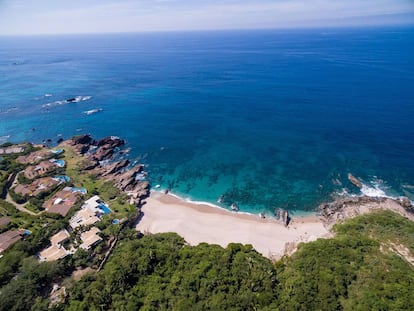In Spain, luxury tourism proves resistant to the effects of the Covid-19 pandemic
Hotel occupancy rates, air taxi services and private yacht rentals continue to post excellent figures and industry leaders expect next summer to be even better

Private villas with all the services of a hotel. Luxury suites in the most desirable locations. Swimming pools with fantastic views. Nights spent inside comfortable yachts moored near a beach. In Spain, the kind of exclusive tourism that only the wealthiest can afford has not been significantly affected by the coronavirus pandemic: this past summer the sector returned to 2019 figures, and in some cases improved on them.
General tourism statistics do not clearly reflect this evolution, partly because they measure aggregate arrivals and expenditure. But there are a few clues: there were 44,114 private jet and air taxi flights during July, August and September of this year, up 20% from the same period in 2019. And these flights carried 90,929 passengers, a 14% rise from 2019, according to Aena, the Spanish airport authority.
Pablo Carrington, a founding partner and CEO of Marugal, a hotel management firm that runs seven luxury establishments in Spain where rooms range from €400 to €3,500 a night, points to the Balearic Islands as an increasingly popular destination for upscale tourism.
“This summer has been excellent there. Compared with 2019, occupancy rates and prices have been somewhat higher,” he says, while cautioning that “this has been an atypical year because Europeans have not taken long-range trips. There’s been a lot of borrowed tourism.”
Figures from Aena show a noticeable increase in luxury tourist arrivals, which are unaffected by special offers – on the contrary, these visitors either have their own planes or they can afford to rent one for themselves.
And statistics show that these flights have landed overwhelmingly on the Balearic islands of Ibiza and Mallorca, as well as in Málaga and the wider Costa del Sol. Even last year, in the middle of the pandemic, these flights did not dip significantly, underscoring how even the coronavirus has been unable to make a dent in a small but strong sector in Spain.
In terms of passengers, there was a 20% fall in the numbers that arrived on private flights and air taxi services in Ibiza in the summer of 2020, but this year the figure surged 12.5% above pre-pandemic levels. It is a similar story in Málaga, where passenger numbers fell 26.5% in the summer of 2020 but rallied back by as much as 40% this year.
But the clearest case is Palma de Mallorca: the dip last summer was barely noticeable, just 0.34%, and this year there has been a nearly 62% increase, from 10,396 passengers up to 16,820 this year.

Meanwhile, the retail sector that caters to high-end visitors has also felt the improvement. Although luxury tourism represents a small portion of total visitor numbers, it pumps the most revenue into local economies. According to the travel advisor site Virtuoso, which brings together elite travel agencies, these tourists spend an average of $20,000 per trip and household.
“Marbella is where we’ve seen the most relevant uptick in sales in luxury areas. As a matter of fact, the summer season has been extended there, hotel prices have gone up and it’s now a hot destination,” says Javier Fernández Andrino, director of the international and luxury client area at El Corte Inglés, Spain’s leading department store chain. But there is still work to be done, he notes: “Spain’s goal should be to promote itself better at home. It needs to show off the best version of national destinations.”
Other hotel chains specializing in the luxury sector agree that figures are improving and that 2022 will likely be even better. A spokesperson for Palladium, which operates brands such as Bless and Ushuaïa Ibiza, says they exceeded their own occupancy forecast this summer, and that in some hotels there were more guests this year than in pre-pandemic years.
A similar view is held at the hotel chain Meliá, which has luxury hotels in Marbella and the Balearic Islands. “It’s been a very good summer, with double-digit growth of room rates at luxury hotels,” says Alfonso del Poyo, vice-president of Meliá in Spain.
“In Palma, the luxury sector has been a success,” adds Natalia Seoane, director general of Hotel de Mar Gran Meliá. “Although occupancy rates have not been as high as other years, we’ve managed to offset that with higher average room prices that were 25% more expensive than in 2019 due to the extremely high demand for our top rooms and suites.”
The situation is not quite as rosy in the Canary Islands, where industry sources point to two factors: not being as well positioned within the luxury sector and the fact that the high season starts at the end of the year due to the climate conditions of this archipelago located off the northwestern coast of Africa. One example is the Royal River complex, which offers individual villas with hotel services and priced at anywhere between €300 and €3,000 a night. “This summer we were at 75% of pre-pandemic levels, but over the winter months we expect to see this rise to 85%,” says José Fernando Cabrera, president of Grupo Golf Resort, which is part of Royal River.
Yacht fever
This trend is not unique to Spain or to the hotel and retail sectors. Other parts of Spain have experienced even bigger jumps in luxury tourism expenditure. Alejandro Reynal, CEO of travel management company Apple Leisure Group, says the pandemic has driven up demand for more sophisticated vacations across the world. “In the Caribbean region, we’ve been seeing exponential growth in high-end trips since June,” he says.
Another visible effect of the boom in luxury tourism is the spike in private yacht rentals. The trend was on display this past summer everywhere along the Mediterranean coastline, as companies rented out all their available vessels for weeks at a time despite prices that are off limits to regular tourists.
In Spain, this particular trend has been especially noticeable in the Balearics and Costa del Sol, with similar figures reported in other countries such as Italy, Greece and Croatia. “It’s been incredible for the yacht sector, with more organized and higher-quality outings than in 2019,” says Mitja Mirtic, CEO of the Croatia-based company Goolets. “The more luxurious boats were booked easier and faster than the standard ones.”
Tu suscripción se está usando en otro dispositivo
¿Quieres añadir otro usuario a tu suscripción?
Si continúas leyendo en este dispositivo, no se podrá leer en el otro.
FlechaTu suscripción se está usando en otro dispositivo y solo puedes acceder a EL PAÍS desde un dispositivo a la vez.
Si quieres compartir tu cuenta, cambia tu suscripción a la modalidad Premium, así podrás añadir otro usuario. Cada uno accederá con su propia cuenta de email, lo que os permitirá personalizar vuestra experiencia en EL PAÍS.
¿Tienes una suscripción de empresa? Accede aquí para contratar más cuentas.
En el caso de no saber quién está usando tu cuenta, te recomendamos cambiar tu contraseña aquí.
Si decides continuar compartiendo tu cuenta, este mensaje se mostrará en tu dispositivo y en el de la otra persona que está usando tu cuenta de forma indefinida, afectando a tu experiencia de lectura. Puedes consultar aquí los términos y condiciones de la suscripción digital.
More information
Últimas noticias
Maduro pleads not guilty before the federal court in New York: ‘I am still the president of Venezuela’
A new test can detect Alzheimer’s from a finger prick
UN team enters Sudanese city of El Fasher after paramilitary massacre: ‘It’s like a ghost town’
A recipe for resistance: Indigenous peoples politicize their struggles from the kitchen
Most viewed
- Gilles Lipovetsky: ‘If you want to live better and fall in love, take Prozac, don’t look to philosophy’
- Alain Aspect, Nobel laureate in physics: ‘Einstein was so smart that he would have had to recognize quantum entanglement’
- Alvin Hellerstein, a 92-year-old judge appointed by Bill Clinton, to preside over Maduro’s trial in New York
- Why oil has been at the center of Venezuela-US conflicts for decades
- Maduro’s downfall puts China’s relationship with Venezuela to the test











































